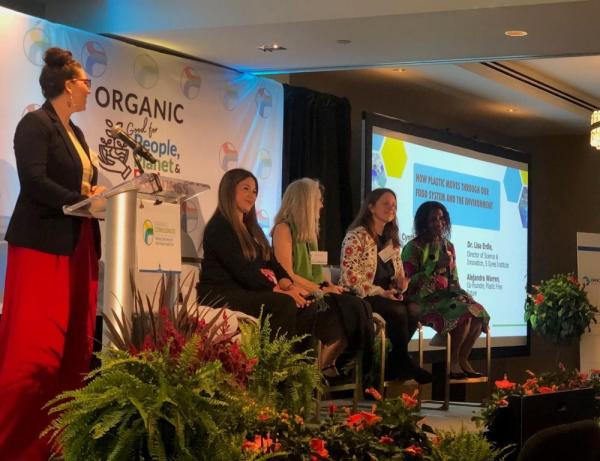eOrganic author:
Alice Formiga, eOrganic, Oregon State University
The Organic Center and the Organic Trade Association held the Organic Confluences conference on May 9 and 10, 2023 in Washington, DC. The theme was Reducing Plastic Across the Entire Organic Supply Chain. As Dr. Amber Sciligo, Director of Science Programs at the Organic Center stated during her introductory remarks, plastic is the Achilles heel of the organic supply chain. While plastics serve many practical purposes on organic farms as well as for packaging and distribution, plastic production, use, and disposal cause massive amounts of pollution, which disproportionately affects low-income people and communities of color in the United States and around the world. At the conference, farmers, researchers, policymakers, wholesalers and retailers, nonprofit organizations, government agency staff and many others gathered to define the challenges in reducing plastic use, identify research needs, highlight success stories, and discuss what needs to be done to solve this growing problem. In line with the goals of the conference, the Organic Center staff put a great deal of effort into reducing plastic waste at the venue: attendees sported paper nametags embedded with wildflower seeds, and enjoyed breakfast and lunch on linen-free tables with metal cutlery. Food waste was composted, and the program was available only in digital rather than printed form. This article describes some of the highlights of the conference, but the full program and list of speakers, and the slide presentations are available on the Organic Center website.
 |
Photo credit: Alice Formiga.
During the first morning session, Cynthia Barstow of the nonprofit organization Protect our Breasts spoke of the huge increase in plastic production in the 21st century, the environmental contaminants used in oil extraction and fracking that are done to produce plastic, as well as the many toxins in plastic additives. Many of these chemicals leach into the soil, air and water, and cause human health problems. Dr. Lisa Erdle, of 5 Gyres Institute, a nonprofit devoted to reducing plastic pollution, pointed out that there is limited toxicology information for all the many chemical additives in plastic. While there are many compostable, biodegradable, recyclable or reusable plastic products, they can only be disposed of in these environmentally friendly ways if facilities to collect and process these materials are available—which is often not the case. Alejandra Warren, Executive Director of the nonprofit Plastic Free Future discussed how plastic disposal often exacerbates social and racial injustices: plastics are often incinerated, buried or dumped in low-income areas. They are also sent to Southeast Asia, and Central and South America, causing pollution and health problems there. Dr. Dana Nettles of Dr. Nettles Natural Beauty explained some of the ways she has reduced plastic use on her medicinal herb farm. While she uses plastic drip irrigation to conserve water, she uses cardboard and wood chips instead of plastic mulch and doesn’t use plastic seed trays. She also reminded the audience that many weeds, some of which she harvests for use in her products, have healing properties!
In the second session, presenters discussed some of the many uses of plastics in organic agriculture, along with attempts to develop biodegradable plastics. Dr. Carol Miles of Washington State University Extension has been researching the end-of-life challenges of plastic mulches for many years. She reported that in 2017, 1.4 million metric tons of PE mulch was used, and the amount increases each year. And it doesn’t just go “away” after the end of the season: much of it ends up in landfills, is stockpiled on farms, buried, burned, or incinerated. In most areas, facilities to transport and recycle it don’t exist, and it isn’t recyclable unless it is cleaned of soil and plant debris, and the impact of chemical contamination is unknown. Dr. Miles and her collaborators have also been experimenting with soil-biodegradable plastic mulch which isn’t recyclable, but it can be tilled into the soil after use. She emphasized that the level of biobased materials is not equivalent to the biodegradability of plastics, and that oxo- and photo-degradable plastics are not biodegradable. Further, we need to expect different rates of biodegradation in the field based on environmental factors (e.g., moisture, temperature, sunlight). No biodegradable plastic mulches are currently permitted in organic production in the U.S., although they have been allowed in Europe for the past decade. Before using any product on your organic farm, make sure itis listed in your Organic System Plan and approved by your USDA-approved certifier. If you are trying to deal with an unanticipated pest problem, get approval from your certifier before using a product that is not listed in your plan—doing otherwise may put your certification at risk. Further investments in research are needed to understand the effects of plastic particles in the environment, and regulations can stimulate the development of technological solutions and recycling infrastructure.
David Gonthier of the University of Kentucky presented USDA OREI funded research (Iowa State, Cornell, and UK) highlighting the utility of some plastic-based protection systems. His colleagues Nieyan Cheng and Wendong Zhang surveyed 377 organic growers about their use of plastic-based protection systems and found that 70% of respondents use high tunnels and 88% use row covers. Their research suggests row covers are more efficient and profitable when compared to OMRI-compliant insecticides in crops such as squash and melons. Survey respondents highlighted that these protection systems regulate the climate, protect crops from pests and diseases, increase yields and quality, and extend the growing season—and are therefore currently vital to local and organic production.
Representatives from several large organic food companies talked about the challenges of developing alternative packaging. For example, Camille Herrera of Driscolls discussed reducing the amount of plastic in their ubiquitous clamshell berry packages by substituting a thinner plastic film for the hard plastic top. Renaud de Rosiers of Amy’s Kitchen said the bowls and cutlery that come with their frozen meals are not recyclable when they are coated with food residue; however, they are compostable— if there is a facility that accepts them. Jason Cleaver of Three Mile Farm discussed paper potato bags, which are smaller than some plastic bags since they aren’t strong enough to hold as many potatoes. Also, many customers prefer to buy produce when they can see the contents through the packaging, so they are developing a paper bag with a net window. It can take time for consumers to accept changes in packaging— but it is important to persist and promote alternatives, because if nothing changes, plastic pollution will only increase.
During the panel discussion after lunch, Katherine DiMatteo, longtime former leader of the Organic Trade Association, reflected on the development of the Organic Rule in 1988-1990, to answer the question of why plastic use was not included in the organic regulations. Since she knew that no single individual would remember this history the same way, she also asked the farmers and retailers in the audience who were there to share their own memories. Back then, it was hard for them to imagine the current scale of plastic waste, because organic production was so much smaller in scale than it is now. Most organic produce was sold in bulk at farmers’ markets and coops, and plastic packaging didn’t come up in the discussions. At that time, synthetic fertilizers and pesticides were of greater concern. Some of the provisions in the Final Rule created unintended consequences regarding plastic packaging. For example, because of the need to prevent comingling of organic and non-organic produce, many vegetables like cucumbers or cauliflower are now often wrapped in plastic to distinguish them from conventional ones—and unless you buy produce in bulk, chances are your vegetables and fruit come with a noncompostable plastic sticker. One of the farmers in the audience stressed the need for cost-effective solutions so that farmers can afford to adopt them. Another participant emphasized the importance of the Haudenosaunee principle of thinking about the effects of farming practices on seven generations into the future.

Photo credit: The Organic Center.
The second morning of the conference featured short presentations regarding the complexities of regulating synthetic materials in organic farming that are not inputs like fertilizers or pesticides, new recycling regulations, and more innovative ways that businesses and organizations are reducing plastic use and raising public awareness about plastic waste. For example, Jazmine Mejia-Muñoz, who is the Water Quality Coordinator at the California Marine Sanctuary Foundation, described how she is assisting growers to recycle some of the vast quantity of plastic mulch and drip irrigation tape, which is discarded in the California Central Coast region, to keep it out of watersheds. Rhodes Yepsen of the Biodegradable Products Institute presented a case for changing the NOP rule to allow for substances such as compostable produce stickers, which some countries are requiring, in organic compost (although unless all stickers were compostable, it would be very difficult to tell which ones were). Mike Dill of Earthbound Farm showed how they reduced 95% of the shrink wrap they had previously used for ripening bananas by using cloth “banana blankets” instead! Lisa de Lima of MOM’s Organic Produce gave many examples of how their store reduced excess plastic, for example by discontinuing the sale of bottled water, and selling produce and products like shampoo and household cleaners in bulk only.
In addition to local efforts and technological innovations, coordination among countries, national, state and local governments, and organic certification agencies will be necessary to develop sustainable and enforceable standards for agricultural plastic and packaging. While the pace of regulation is often slow, especially when it comes to figuring out who will pay for implementing solutions, the need for changes to reduce plastic pollution is urgent, and not only within the organic supply chain!
In one of the highlights of the morning, artist Cynthia Minet showed slides of the illuminated animal sculptures she creates out of discarded plastic, such as this elephant, to draw attention to the problems of plastic pollution. View more of her work on her website at https://cynthia-minet.squarespace.com/.

Unsustainable Creatures: Elephant. Cynthia Minet. Photo credit: Lawrence Pierce. https://cynthia-minet.squarespace.com/#/entangled-at-the-animal-museum/
The Organic Center will be incorporating the many ideas and research needs mentioned by participants in the breakout sessions into future programming like webinars and future reports. Funding for the conference was provided by a grant from NIFA OREI and National Co+op Grocers. Find information about past Organic Confluences Conferences at https://eorganic.info/organicconfluences.



